Read on to learn about:
- Which materials are good candidates for slide bearings
- 3 common low-friction solutions
- What is coefficient of friction and how is it measured?
What methods are used to create low-friction movement?
- Wheel, roller, or ball (bearing)
Common and fairly easy to create using catalogue engineering components. Ideal for rotation. Often a bearing will be sealed for life and contain all of the necessary grease or lubricants. One disadvantage is cost, complexity and size, especially for simple linear mechanisms. - Lubricants - adding oil or water (a whole scientific field called tribology)
Adding a lubricant is a very good way to reduce friction, we use it every day to help reduce friction in the CNC cutting process. But it has its limitations, it can contaminate and tends to evaporate or attract dirt, which can then accelerate wear. - Dry sliding (slideways or bearing faces)
Dry slideways depend on the materials properties to establish a low friction union. In most cases it's a pairing of a hard and softer material (sometimes sacrificial). A little of the softer material deposits slightly polishing and smoothing the mating faces over time.

First off, let’s describe a sliding bearing. Think of a gear in a robot rotating or engine part reciprocating; or a door or draw sliding in and out. It’s a mechanical part that allows relative movement between two moving parts with minimum friction. As well low friction, the parts should maintain their relative positions consistently, without wearing.
Slide bearings are a critical component in many engineering applications, they provide a smooth, low-friction surface that allows parts to move back and forth multiple times, with a long service life. CNC machining materials play a key role in their performance, choosing the right material for slide-bearings is essential. CNC machining can be used to create custom components from various materials, with a good surface finish and tolerance, making them ideal for creating precise parts with exact specifications.
What materials are good for slide bearing applications?
Not all materials are appropriate to produce slide-bearing parts. Materials should be friction resistant and durable as parts complete repetitive actions, so they must resist wear. The most important consideration is the life cycle – how many rotations or operations are expected? There are other properties to consider, such as compressive loads, desired operating loads and fatigue strength. Environmental conditions such are dirt ingress, corrosion resistance and structural uniformity. Considering all these features will improve the performance of a slide-bearing application.
Some materials have key characteristics in their natural state, such as Nylon (PA), Acetal (POM), PTFE (Teflon), PEEK, PPS and Bronze. Other materials need treatment to give them those characteristics, such as aluminium, which can be hard anodised to reach the required state, or Carbon chromium steel, a steel alloy that contains chromium to increase hardness and make it more resistant to wear and tear.

Protolabs offer several material options that are great for sliding-bearing applications:
Soft materials (good for bearings gears or bushings)
PTFE (Teflon) / Pared with almost any material, including other plastics
A common choice by aerospace industries and in mechanical engineering. Teflon has impressive slide and wear properties, Teflon has the lowest coefficient of friction of any plastic, with the bonus that it requires minimal maintenance. It also boasts good UV and weather resistance, electrical insulation, chemical resistance and is flame retardant. Teflon has a high load-bearing capacity, ideal for larger, heavier requirements such as engines and automatic sliding doors. If that hasn’t sold it to you, perhaps its reasonable price tag will!
PEEK / pared with metal bearing surfaces
The go-to and do-all plastic for high-end aerospace, F1 and medical applications. PEEK has excellent sliding friction properties and offers high thermal stability, resistance to radiation, chemicals, hydrolysis and moisture, minimal thermal expansion and very low outgassing rates in a vacuum. It is recognised as having very high wear resistance for a plastic but also a high price! Its most common uses include sliding components, gaskets, guide rollers, chain guides in ovens, pumps, motors, turbines, water-lubricated compressors, gears and engine building.
POM (Acetal or Delrin®) / pared with metal bearing surfaces
Acetal is perfect for sliding-bearing applications because of its excellent dimensional stability and low friction. Its high stiffness, decent wear resistance and reasonable price tag are all good reasons for choosing this material for your part. It is more dimensionally stable and much less hydroscopic than nylon (which can absorb water). The material is widely used in automotive and consumer electronics; common applications include ball bearings, small gear wheels, bindings and fasteners.
Phosphor Bronze (available soon) / pared with steel bearing surfaces
Phosphor bronze is one of the most popular materials used for slide-bearing applications due to its excellent properties, such as high strength, low coefficient of friction, and good corrosion resistance, so much so that a bearing made from Bronze that is properly maintained can outlast the equipment it serves. Phosphor bronze forms a thin layer of tin oxides on its surface, which gives bearings made from this material exceptional friction reduction and wear resistance. It is ‘self-lubricating’. To top it off, it has good CNC machinability, which is how we will be making your components.
Phosphor bronze is used in a variety of applications, including aerospace, automotive, engineering and marine. It is commonly used in bearings, gears, springs and bushes.

Hard materials (good for bearing surfaces)
Aluminium (with anodising) / Pared with PTFE or plastic bearings
Aluminium has many benefits, including high strength, good corrosion resistance, lightweight, and cheaper than steel. In its purest form, aluminium is not the ideal choice for sliding bearings; however, the material can be made to fit with an additional anodising finish. An anodised aluminium part has longer-lasting corrosion resistance and a harder surface for wear resistance. Choosing Hard anodising with result in a thicker and even harder wearing coating.
Carbon Steel / Pared with bronze or brass bearings
Carbon steel is one of the more commonly used metals for sliding bearings, and EN8 (that Protolabs offers) can be heat treated to provide a good surface hardness and moderate wear resistance, both ideal for slide and bearing applications. Often used when mild steel does not offer the required properties. Applications include general-purpose axles, gears, spindles, engineering components, bolts and studs.
What is the best way to test a bearing?
A 3D assembly can and should be sued to confirm all of the moving parts mesh correctly, but practical application is the best way to test any product that has moving parts and bearings. Firstly, confirm everything moves smoothly, a sticking component is going to impact useability. Secondly a lifetime or endurance test will ensure everything continues to work – this is best automated to create an ‘accelerated life test’ and can be sued to simulate the worst (hottest, dustiest) environments your product is likely to encounter. Protolabs quick manufacturing service is ideal for small batches of parts – so you could test several different materials if required.
In Summary
From an engineering standpoint, it’s important to not only select the appropriate type of material but also to pay attention to how it is machined. Ensuring accuracy and uniformity for each part produced is critical as it helps reduce friction between surfaces during operation so you can get the maximum product performance. Additionally, when designing these components, make sure there’s ample clearance so they don't rub or foul anywhere other than the bearing, as this will result in unexpected wear.
With careful consideration of your slide bearings design, the material that will be used and how it is maintained, you can produce some incredible sliding mechanisms that will outlast your product.
FAQ
How is coefficient of friction measured?
It takes 2 surfaces to generate friction, so to take a measurement a standardised stainless steel sheet is used. The test material is loaded with a force (weight) and the force to drag the test material and weight is measured. Anything with a coefficient (all coefficients are unitless ratios) of <0.1 is considered good. So is a sledge weighed 100 kg it could be pulled with a 10 kg load (in reality the coefficient between snow and a HDPE sledge has a much lower coefficient).[1]
Famous or notable low-friction mechanisms
The Millau Viaduct: Millau Viaduct is a modern engineering wonder. The slender pillars were constructed, and the roadway assembled on each side of the gorge. The challenge was to slide the roadway out across without pushing over the pillars! Pairs of sliding wedges with PTFE slideways were actuated back and forth. Repeating this both gently lifted and pushed the massive road deck slowly across the 2500 m or 8000 feet span.[2]
Antikythera mechanism: Dating from 100 BCE, one of the oldest and most complex mechanisms and still an enigma. Constructed from bronze, probably to ensure the 30 gear wheels rotated smoothly. The excellent corrosion resistance of bronze helped it survive over 2000 years on the seabed.[3]
Reliable and portable time: Harrison produced the H1 timekeeper in 1735. This revolutionised navigation, accurate time enabled longitude to be measured. Less well know is how. Most clocks and watches were delicate and fickle. Harrison realised that friction was key, by replacing oil based lubricants (which would evaporate and so change the coefficient of friction over time) with low friction solids – specific hardwoods first then ruby “jewels”.[4]
Which materials have the lowest coefficient of friction?
- BAM
- Diamond and diamond like coatings
- Ice (at melting point)
- PTFE
Of all of the lowest friction materials PTFE is the most practical – it can be formed and machined and has a reasonable cost. It’s only disadvantage is toughness, as it is quite a soft material it needs to be pared with a smooth (machined) surface.